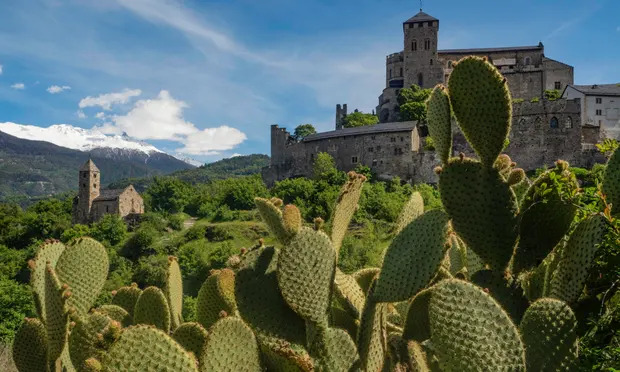The residents of the Swiss canton of Valais are used to seeing their mountainsides covered with snow in Winter and edelweiss flowers in Summer. But as global heating intensifies, they are increasingly finding an invasive species colonising the slopes: cacti.
Authorities say cactus species belonging to the genus Opuntia, or prickly pears, are proliferating in parts of Valais, encroaching on natural reserves and posing a biodiversity threat.
“A lover of dry and hot climates, this invasive and non-native plant is not welcome in the perimeter of prairies and dry pastures of national importance,” the municipality of Fully in the Rhone valley said in a press release announcing the uprooting campaign in late 2022.
Opuntia species and similar cacti have also proliferated in some of the hills around the capital of Valais, in Sion, where estimates suggest Opuntia plants now make up 23-30% of the low vegetation cover. Their presence has also been reported in neighbouring Alpine regions, including Ticino and Grisons in Switzerland, and the Aosta valley and Valtellina in Italy.
–
“In some parts of Valais, we estimate that the cacti can occupy one-third of the available surface,” says Yann Triponez, a biologist who works in the canton of Valais’ nature protection service. He says Opuntia have been present in Valais at least since the late 18th century, when it was imported from North America.
But authorities believe that a warmer climate in the Alps, allowing for longer vegetation periods, and the diminishing snow cover might be creating the ideal conditions for them to spread.
“These species bear -10C or -15C without any problem,” says Peter Oliver Baumgartner, a retired geology professor with a longstanding side interest in botany who has been commissioned by the canton to study and write a report on the plants. “But they want to be in a dry place and don’t like snow cover.”
Snow is becoming rarer at lower altitudes, even in the Alps. According to Meteo Swiss, the number of snow days under 800 meters of altitude in Switzerland has halved since 1970. A recent study published in Nature Climate Change said snow covers the Alps for about a month less than historical averages and called the situation “unprecedented in the last six centuries.”
–
A map showing the spread of prickly pairs across the Swiss mountainside.
–
Temperatures across the range have been rising twice as fast as the global average, and average temperatures in Switzerland are already 2.4C warmer than 1871-1900 averages. “If you look at climate change reports,” Baumgartner says, “the curves for Switzerland are almost as steep as for the Arctic.”
Nine species have spread on sunny, south-facing slopes below 700 meters of altitude, where they compete with endemic and sometimes threatened species. “Valais is one of the biodiversity hotspots in Switzerland,” says Triponez. “We have about 3,000 species of plants in Switzerland, and some 2,200 are in Valais.”
He says authorities are worried by the cacti’s spread to natural reserves and protected areas. “When you have these cacti, nothing else grows,” says Triponez. “Each pad covers the soil and prevents other plants from growing through.”
Baumgartner says that only four of the nine Opuntia species in Valais represent a threat to local ecosystems, particularly in areas with acid or neutral soils, which account for one-third of the valley’s south-facing slopes.
–
Quantitative data about their spread is incomplete because Baumgartner’s report, which has not yet been published, is the first recent attempt to estimate the plants’ presence in the region. But Baumgartner says there is abundant evidence of their proliferation in several areas he has visited.
The uprooting campaign will resume in the next few weeks in Fully, and Triponez says authorities have also launched an awareness campaign to inform residents, who sometimes plant the cacti, and tourists about the threat.
Preventing Opuntia from proliferating will not be an easy task. The plants reproduce easily, growing back even when felled, stepped on by hikers or left dry for months, and recover quickly after they are uprooted.
–
A decade ago, eradication campaigns were unsuccessful in Sion. In Fully, when the species were uprooted last year, the plants were heaped up in a forest, where authorities thought shade and humidity would make them rot and compost. But when Baumgartner visited the heap, the pads at the top appeared to be thriving. At the same time, the cacti are also growing back in most places they were uprooted from, making biologists like Baumgartner doubt whether the cacti can be eradicated at all.
“We can restrict them,” he says. “But I don’t think we can get rid of them.”
–
Sign up to Down to Earth – Free weekly newsletter
The planet’s most important stories. Get all the week’s environment news – the good, the bad and the essential
Privacy Notice: Newsletters may contain info about charities, online ads, and content funded by outside parties. For more information see our Privacy Policy. We use Google reCaptcha to protect our website and the Google Privacy Policy and Terms of Service apply.
–
Topics
Most viewed
- –
- –
- –
- –




















